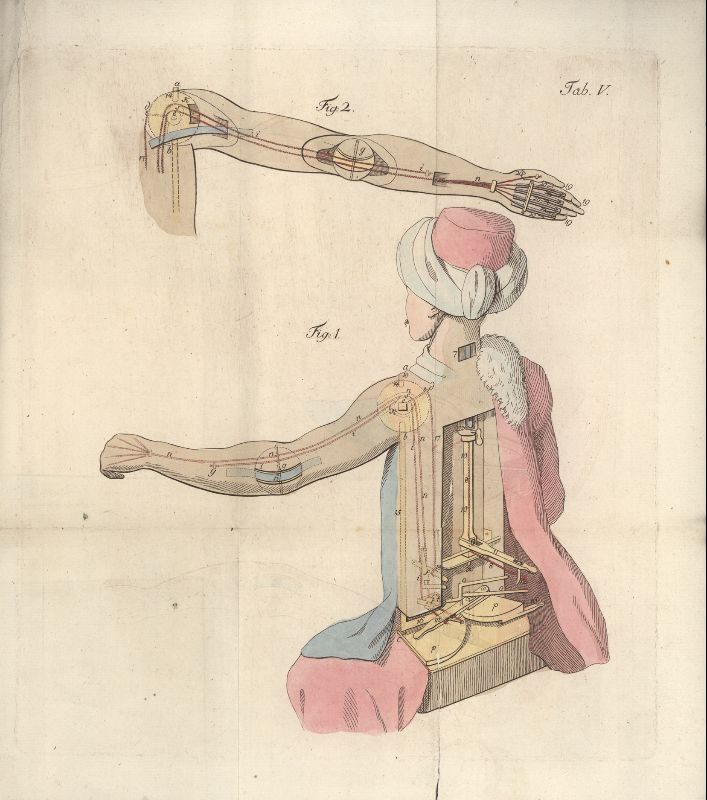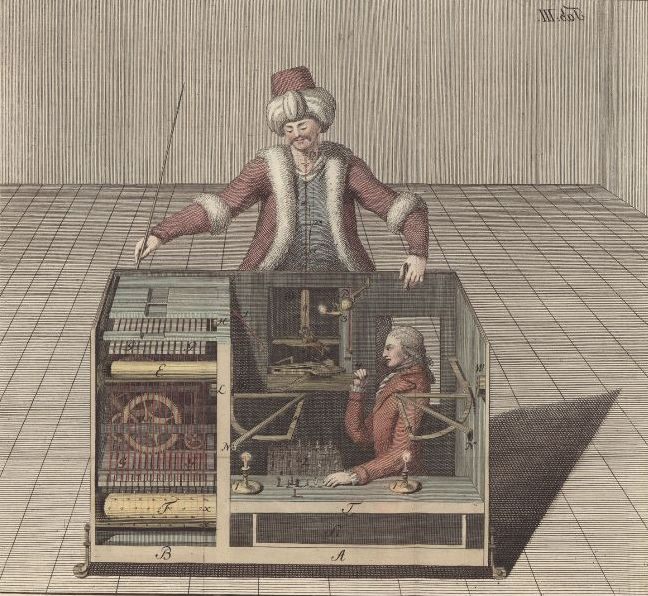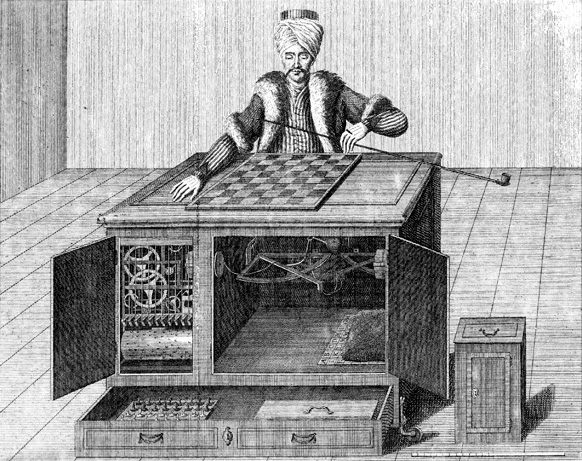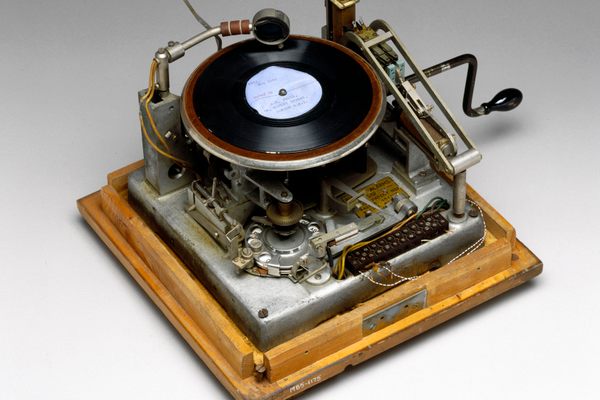Object of Intrigue: The Turk, a Mechanical Chess Player that Unsettled the World

A reconstruction of the Turk. (Photo: Marcin Wichary/Creative Commons)
Warnings over the perils of artificial intelligence arms races have made headlines of late, but debates over the possibilities of AI have been raging since the ’70s.
The 1770s.
At the dawn of that decade, an inventor by the name of Wolfgang von Kempelen debuted his latest creation in Vienna: A chess-playing automaton made for Habsburg Archduchess Maria Theresa. Known initially as the Automaton Chess Player and later as the Mechanical Turk—or just the Turk—the machine consisted of a mechanical man dressed in robes and a turban who sat at a wooden cabinet that was overlaid with a chessboard. The Turk was designed to play chess against any opponent game enough to challenge him.
At the Viennese court in 1770, Von Kempelen began his demonstration of The Turk’s workings by opening the doors and drawers of the cabinet and shining a candle inside each section. Inside were cogs, gears, and other clockwork. After closing the cabinet, von Kempelen invited a volunteer to serve as the Turk’s opponent.
Gameplay began with the Turk moving his head from side to side to survey the board before appearing to decide on the first move. His left arm then jerked forward, the fingers splayed, and he picked up a chess piece, moving it to another square before setting it down.

The inner workings of the Turk’s arm, as envisioned by Joseph Racknitz. (Image: Public domain)
So far, this was relatively standard stuff—at the time, automata in the form of mechanical animals and expressive humanoids had delighted many a royal and commoner. One of the most prominent automata makers, Jacques de Vaucanson, had not only created the Digesting Duck—which wiggled its beak, quacked, and pooped out pellets it had been fed—but also the Flute Player, an automaton that could, in the words of Tom Standage in The Turk, ”mimic almost all of the subtleties of a human flute player’s breathing and musical expression.”
Compared to these masterful simulacra, the Turk, with his expressionless face made of carved wood and jerky arm movements, initially seemed an inferior product. But then came the rest of the chess game. The Turk was good. Really good. And it wasn’t just adept at executing a repetitive task. The Turk responded skillfully to the unpredictable behavior of humans. This machine seemed to be operating autonomously, guided by its own sense of rationality and reason. If the human opponent attempted to cheat, as Napoleon did when facing off against the machine in 1809, the Turk would move the chess piece back to its previous position, and, after repeated cheating attempts, would swipe his arm across the board, scattering pieces to the ground.

The Turk serving up some side-eye to those who doubt his intelligence. (Photo: Carafe/Creative Commons)
Of course, there had to be a trick to all of this. But the nature of the deception was, for many decades, elusive. Following the 1770 demonstration, which astonished Maria Theresa and her attendants, von Kempelen, an engineer rather than an entertainer, was content to let the Turk rest. The automaton sat in a neglected state until after Maria Theresa’s death, when her son and royal successor, Joseph II, remembered the Turk and asked von Kempelen to revive it. In 1783, von Kempelen took the Turk on tour to Paris, where he once again astonished onlookers—including a certain chess-loving American by the name of Benjamin Franklin.
Tours of England and Germany followed over the next year. During this time, people began to publish their speculative accounts of the Turk’s workings. Some, such as British author Philip Thicknesse, were indignant at the notion that the Turk was a purely mechanical creation whose gameplay was free from human influence. “That an AUTOMATON can be made to move the Chessmen properly, as a pugnacious player, in consequence of the preceding move of a stranger, who undertakes to play against it, is UTTERLY IMPOSSIBLE,” wrote Thicknesse in a critical pamphlet he passion-published in 1784. (The immoderate word capitalization is all his.)

An exhibition ad from 1818. (Image: Public domain)
Thicknesse did not believe, as others did, that von Kempelen was directing the Turk’s gameplay from several feet away using strong magnets, stealthy strings, or remote control. His opinion took the Occam’s Razor approach, with a child-labor twist: He wrote in his pamphlet that the cabinet must be concealing ”a child of ten, twelve, or fourteen years of age”—presumably one whose chess talents were prodigious.
The notion that someone was hiding in the cabinet was espoused frequently over the decades, with variations on the size of the hypothetical person as well as their positioning. The cabinet measured four feet long, two-and-a-half feet deep, and three feet high—dimensions that encouraged people to speculate that short-statured people and children were the most likely candidates for the role of hidden Turk operator. Some believed that the concealed person stayed in the cabinet the whole time, using strings, pulleys, and magnets to execute the chess moves, while others thought the operator crawled up into the body of the Turk in order to control him.
Then there was the complication of the pre-demonstration routine in which von Kempelen would open the cabinet doors and drawers and shine a candle inside, seemingly precluding the presence of a human. But this, too, was cited as a mere trick—in 1789, Freiherr zu Racknitz proposed that the concealed operator hid in the back of the cabinet’s bottom drawer during the pre-game display, then moved to the main portion.

Could there be a tiny man inside? Racknitz thought so. (Image: Public domain)
The most outlandish tale of a hidden operator comes from Jean Eugène Robert-Houdin, a French magician who encountered the Turk in 1844—long after its heyday. In his 1859 memoirs, Robert-Houdin passed on the Turk’s origin story—a clearly apocryphal tale that he nonetheless described in great detail. According to Robert-Houdin, von Kempelen was in Russia during the 1790s when he met a doctor named Osloff. The doctor was sheltering a fugitive Polish soldier, Worousky, whose legs had been blasted away by a cannonball. This soldier happened to be a gifted chess player. So von Kempelen did what anyone would do in the situation: spent three months building a fradulent humanoid automaton chess player machine equipped with a cabinet large enough to house Worousky, thereby smuggling him out of Russia to safety by touring the automaton through major cities. A foolproof plan if ever there was one.
Such outlandish stories, while entertaining, added unnecessary complications. The truth was simpler: the Turk did operate via a concealed operator, who controlled each movement from inside the cabinet by candlelight, pulling levers to operate the Turk’s arm and keeping track of the moves on their own board. Von Kempelen, and his Turk-touring successor, Johann Maelzel, picked up new chess players on their travels, gave them a quick how-to orientation, then bundled them into the cabinet.
Though the machine ultimately relied on human behavior and a bit of old-fashioned magic, its convincingly mechanical nature was cause for both wonder and concern. Arriving smack-bang in the middle of the industrial revolution, the Turk raised unsettling questions about the nature of automation and the possibility of creating machines that could think. The fact that the Turk appeared to operate on clockwork mechanisms, complete with whirring sounds, contradicted the idea that chess was, in the words of Robert Willis in 1821, “the province of intellect alone.” If a machine could play a human game at the mercy of the human whims of its opponent, what else could it do?

Cabinet doors open, nothing here but clockwork. (Image: Public domain)
This was one of the big questions rattling around the young mind of Charles Babbage when he first saw the Turk play when it toured England under Maelzel in 1819. Three years later, Babbage began working on the Difference Engine, a machine designed to calculate and tabulate mathematical functions automatically. It was an early step on the path toward artificial intelligence.
“Unlike the new machines of the industrial revolution, which replaced human physical activity, this fragment of the Difference Engine, like the Turk, raised the possibility that machines might eventually be capable of replacing mental activity too,” writes Tom Standage in The Turk.
In the 1820s and ’30s, Maelzel took the machine for one last hurrah around the northeast United States, during which Edgar Allan Poe developed a fondness for it and wrote his own treatise on the human-assisted operations he assumed were in place during gameplay. But the thrill of the Turk was fading. By the 1850s, with Maelzel having perished during a Turk tour of Cuba, the machine sat forgotten in the Chinese Museum in Philadelphia. It was there that, in 1854, it succumbed to a fire.
Though the Turk could be called a fraud, to regard the machine as a mere trick or swindle is to dismiss the profound and disruptive questions it introduced. The Turk may not have been intelligent, but it pointed toward an all-too-easily imaginable future of machines that can think for themselves—an ethical conundrum with which even the world’s AI experts are still struggling.





















Follow us on Twitter to get the latest on the world's hidden wonders.
Like us on Facebook to get the latest on the world's hidden wonders.
Follow us on Twitter Like us on Facebook